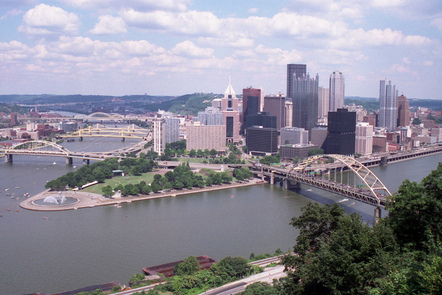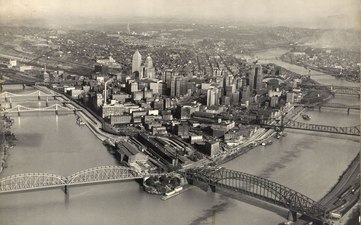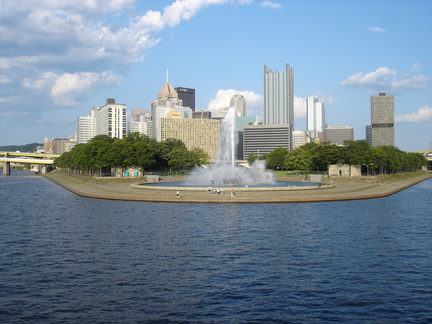Point State Park - Pittsburgh, PA
The city of Pittsburgh is situated in an incredibly scenic stretch of Western Pennsylvania. The downtown area of the city is located at the confluence of the Allegheny and Monongahela Rivers, which combines to form the Ohio River. Surrounding this major aquatic intersection are steep hillsides and a variety of terrain that afford fantastic views of the city and area as well as providing a multitude of recreational opportunities. At the actual point where the rivers merge, a valuable parcel of open space has been developed and is appropriately named Point State Park. However, the point was not always in this pristine condition, and took quite an effort to implement it and help change not only the land scape but also the perception of Pittsburgh.
Pittsburgh and its surrounding region are often characterized as a blue-collar, rough area dominated by declining industry, bad weather, and a polluted environment. However, heavy industry such as steel has largely left the area, and a new economy has struggled to take shape, as is so common among cities and towns along the former industrial belt of Midwest and Northeast. Once the industry left, large abandoned factories and underused warehouses dotted the landscape, displaying a visual representation of economic decline. In the 1950s, the land where Point State park now stands was occupied by warehouses and railroad yards, and was severely underused and polluted. As early as World War II, the city looked to change its development in this pivotal area. It wanted to increase real estate value, reduce traffic congestion in the area, and develop much-needed open space. Consultants were brought in and multiple plans were developed for the area in the ensuing years, including a much-hyped proposal for a large civic center. However, these plans fell through and a park that highlighted the historic importance of the site was created and finally completed by 1974.
In order to turn the land into attractive open space, the state acquired multiple properties located on the site through eminent domain by 1949. The state and the city successfully claimed that it was in the best economic interest of the entire community if the land was seized and ultimately cleared. It was a massive effort, and a heavy amount of environmental remediation was required, as one can understand from viewing this historical aerial photo of the site.
Pittsburgh and its surrounding region are often characterized as a blue-collar, rough area dominated by declining industry, bad weather, and a polluted environment. However, heavy industry such as steel has largely left the area, and a new economy has struggled to take shape, as is so common among cities and towns along the former industrial belt of Midwest and Northeast. Once the industry left, large abandoned factories and underused warehouses dotted the landscape, displaying a visual representation of economic decline. In the 1950s, the land where Point State park now stands was occupied by warehouses and railroad yards, and was severely underused and polluted. As early as World War II, the city looked to change its development in this pivotal area. It wanted to increase real estate value, reduce traffic congestion in the area, and develop much-needed open space. Consultants were brought in and multiple plans were developed for the area in the ensuing years, including a much-hyped proposal for a large civic center. However, these plans fell through and a park that highlighted the historic importance of the site was created and finally completed by 1974.
In order to turn the land into attractive open space, the state acquired multiple properties located on the site through eminent domain by 1949. The state and the city successfully claimed that it was in the best economic interest of the entire community if the land was seized and ultimately cleared. It was a massive effort, and a heavy amount of environmental remediation was required, as one can understand from viewing this historical aerial photo of the site.
|
The resulting park has become a prized civic treasure for the city of Pittsburgh. It has a total of 36 acres and provides a valuable green space in the heart of the urban core of the city. It is operated by the state of Pennsylvania and has established itself as a preferred site for major cultural events and activities for the city and surrounding region. The park was also a pivotal site during the French and Indian War in the 1700s due its location at the confluence of the rivers. As such, two forts were constructed and the remains of them are still on the site. Therefore, the park is also a destination for history buffs. The park also features a famous fountain that sprays water from the Ohio up to 150 feet in the air.
|
Point State Park now symbolizes the altered economy and condition of the city. Pittsburgh has transitioned into a more service-oriented economy and has made tremendous advances in the environmental realm from a city that was once heavily polluted. The park signifies that a disinvested and post-industrial landscape can be altered and turned into something favorable and attractive. It is a great example of a city and state taking a pro-active stance on developing open space and improving the quality of life for all in the surrounding area.



